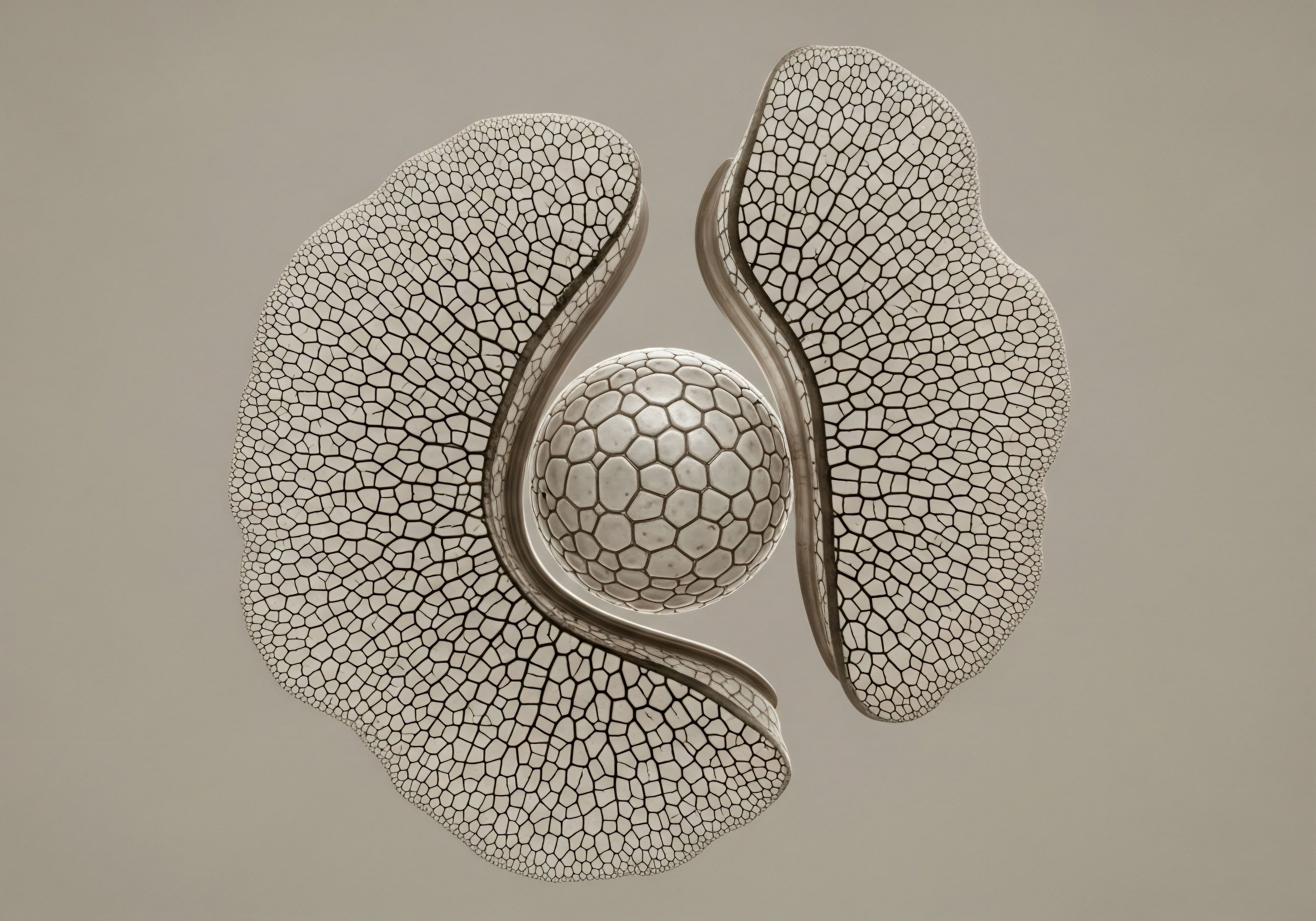

Fundamentals
You may feel it as a persistent lack of energy, a sense of mental fog, or a general feeling that your body is not performing at its peak. These experiences are valid and deeply personal, and they often point toward the intricate biological systems that work tirelessly to maintain your vitality.
One of the central hubs of this internal ecosystem is your liver, an organ of profound capability and resilience. Your liver performs over 500 essential functions, acting as a metabolic powerhouse that processes everything you consume, breathe, and absorb. Understanding how to support this vital organ through your dietary patterns is a foundational step in reclaiming your sense of well-being and function.
The conversation about health often revolves around the heart or the brain, yet the liver operates as the silent, diligent manager of your body’s internal chemistry. It is your primary detoxification center, a sophisticated processing plant that distinguishes between nutrients to be used and harmful substances to be neutralized and eliminated.
This process is far from a simple filtering mechanism. It is an active, energy-dependent series of biochemical transformations that requires a constant supply of specific nutritional resources. When we speak of “detoxification,” we are referring to this elegant, enzyme-driven system that protects your cells from damage and maintains metabolic equilibrium.

The Liver’s Immense Workload in the Modern World
Your body is continuously exposed to a wide array of substances that require processing by the liver. These compounds, known as xenobiotics, come from external sources like environmental pollutants, medications, and industrial chemicals. In addition to external exposures, the liver also processes endogenous substances, which are byproducts of your own metabolic processes, such as used hormones.
The sheer volume and complexity of these exposures in the modern world place a significant demand on your liver’s detoxification capacity. An estimated 80 to 100 million Americans have nonalcoholic fatty liver disease (NAFLD), a condition often without early symptoms, which underscores the silent stress many livers are under. This makes proactive, supportive strategies through diet exceptionally valuable.
The foods and beverages you consume are the most direct and powerful tools you have to influence your liver’s health. Your dietary choices provide the essential building blocks and cofactors that fuel the detoxification machinery. A diet rich in processed foods, sugars, and unhealthy fats can burden the liver, contributing to inflammation and fat accumulation, which may impede its function.
Conversely, a dietary pattern centered on whole, nutrient-dense foods provides the very compounds your liver needs to perform its duties efficiently. This creates a biological environment where your body can manage its toxic load effectively, supporting cellular health and overall vitality.
Your daily food choices directly supply the raw materials your liver requires to manage its complex detoxification workload.

An Introduction to the Two Phases of Hepatic Detoxification
To appreciate how diet influences liver function, it is helpful to understand the basic architecture of its detoxification system. This system is elegantly organized into two main stages, commonly known as Phase I and Phase II detoxification. Think of it as a two-step assembly line designed to convert fat-soluble compounds into water-soluble forms that your body can easily excrete through urine, bile, or sweat.
Phase I is the initial step where a family of enzymes, called the Cytochrome P450 (CYP450) enzymes, chemically transform a substance. This transformation often involves oxidation, reduction, or hydrolysis. The goal of this phase is to make the compound more reactive, preparing it for the next stage. This initial step creates an intermediate molecule that can sometimes be more volatile than the original substance. A well-functioning system requires that this intermediate is promptly handled by the next phase.
Phase II is the conjugation phase. Here, the reactive intermediate from Phase I is attached to a water-soluble molecule. This process neutralizes the compound and makes it ready for elimination from the body. There are several different Phase II pathways, each requiring specific nutrients to function.
These pathways include glucuronidation, sulfation, and glutathione conjugation, among others. The efficiency of these pathways is directly dependent on the availability of nutrients from your diet. Without an adequate supply of these nutrients, the intermediates from Phase I can accumulate, potentially causing cellular stress.

The Crucial Role of Nutritional Synergy
The seamless operation of both Phase I and Phase II is essential for effective detoxification. An imbalance, where Phase I is overactive relative to Phase II, can lead to a buildup of reactive intermediates. Certain lifestyle factors and exposures can speed up Phase I, while nutritional deficiencies can slow down Phase II. This highlights the importance of a holistic dietary approach that supports both phases simultaneously.
Your diet provides the vitamins, minerals, amino acids, and phytonutrients that act as cofactors and building blocks for the enzymes in both phases. B vitamins, for instance, are critical for numerous enzymatic reactions. Minerals like magnesium, selenium, and zinc are essential for enzyme function and antioxidant defense.
Amino acids derived from protein are necessary for specific conjugation pathways. Phytonutrients, the beneficial compounds found in plants, play a powerful role in modulating and supporting these detoxification pathways. This intricate dependency on nutrition means that your dietary pattern is a primary determinant of your hepatic detoxification capacity.


Intermediate
Understanding the foundational concepts of hepatic detoxification opens the door to a more detailed exploration of the clinical and biochemical mechanics at play. The process is a sophisticated interplay of enzymatic reactions, each with specific nutritional requirements.
A well-formulated dietary pattern provides the precise substrates and cofactors needed to support these pathways, ensuring that the body can efficiently neutralize and eliminate both endogenous and exogenous compounds. This section examines the specific dietary components that influence Phase I and Phase II detoxification and introduces the critical connection between gut health, hormonal balance, and liver function.
The body’s ability to manage its toxic load is a direct reflection of the health and efficiency of these metabolic systems. When these pathways are well-supported, the body maintains a state of homeostasis. When they are compromised by nutritional deficiencies or overwhelmed by a high toxic burden, clinical patterns of immune dysfunction or endocrine disruption can arise. Therefore, a therapeutic nutritional approach is a powerful strategy for enhancing the body’s innate detoxification capabilities and promoting overall health.

A Deeper Look at Phase I Biotransformation
Phase I detoxification is primarily mediated by the cytochrome P450 (CYP450) superfamily of enzymes. These enzymes are found in high concentrations in the liver and are responsible for the initial biotransformation of a vast array of substances, including approximately 75% of all pharmaceuticals, as well as metabolic byproducts like steroid hormones. They function by inserting an oxygen atom into the molecular structure of a compound, a process that creates a more reactive site for the subsequent actions of Phase II enzymes.
The activity of CYP450 enzymes can be induced or inhibited by various dietary components. This modulation is a key reason why certain foods can interact with medications. For example, compounds in grapefruit are known inhibitors of the CYP3A4 enzyme, which can slow the metabolism of certain drugs, leading to higher levels in the bloodstream.
Conversely, some substances can induce or speed up CYP450 activity. While this might seem beneficial, an overactive Phase I pathway without commensurate support for Phase II can lead to an accumulation of potentially damaging intermediate metabolites. A balanced approach is therefore essential.

Nutritional Support for Phase I
While Phase I activation is often robust, it still requires a range of nutrients to function optimally and to protect the liver from the oxidative stress it generates. Key nutrients include:
- B Vitamins ∞ Riboflavin (B2), niacin (B3), pyridoxine (B6), and folate are all essential cofactors for various CYP450 enzymes. They are critical for the energy production required to fuel these reactions. Foods rich in B vitamins include leafy greens, eggs, and legumes.
- Antioxidants ∞ Phase I activity generates free radicals, which can cause oxidative damage to liver cells. Antioxidants like vitamins C and E, carotenoids, and selenium help neutralize these free radicals, protecting the integrity of hepatocytes. Citrus fruits, berries, nuts, and seeds are excellent sources.
- Phospholipids ∞ The membranes of liver cells, where these enzymatic reactions occur, are rich in phospholipids. Ensuring an adequate intake of healthy fats, such as those found in olive oil and avocados, helps maintain the structural integrity of these membranes.

The Intricacies of Phase II Conjugation Pathways
Phase II is where the true neutralization happens. This phase involves several distinct conjugation pathways that attach small, water-soluble molecules to the reactive intermediates produced in Phase I. This process renders them harmless and prepares them for elimination. Each of these pathways has unique enzymatic machinery and specific nutritional requirements. A comprehensive dietary strategy aims to support all of these pathways to prevent bottlenecks in the detoxification system.
The efficiency of Phase II detoxification is directly proportional to the availability of specific nutrients that fuel its diverse conjugation pathways.

Key Phase II Pathways and Their Nutritional Needs
The following table outlines the major Phase II pathways and the dietary components that are essential for their function. A varied, whole-foods diet is the most effective way to ensure all these pathways are adequately supported.
| Conjugation Pathway | Primary Function | Essential Nutrients & Food Sources |
|---|---|---|
| Glucuronidation | A primary pathway for metabolizing hormones (like estrogen), bilirubin, and many prescription drugs. It attaches glucuronic acid to toxins. | Nutrients ∞ D-glucaric acid. Sources ∞ Apples, oranges, broccoli, spinach, and other fruits and vegetables. Resveratrol from grapes and berries also supports this pathway. |
| Sulfation | Metabolizes steroid hormones, neurotransmitters, and some drugs. It attaches a sulfur-containing group to toxins. | Nutrients ∞ Sulfur, Molybdenum. Sources ∞ Cruciferous vegetables (broccoli, cauliflower, kale), allium vegetables (onions, garlic), eggs, and high-quality poultry and seafood. |
| Glutathione Conjugation | A critical pathway for neutralizing heavy metals, pesticides, and the harmful byproducts of oxidative stress. It uses glutathione, the body’s master antioxidant. | Nutrients ∞ Glutathione precursors (cysteine, glutamic acid, glycine), selenium, vitamin B6, magnesium, alpha-lipoic acid. Sources ∞ Asparagus, avocado, spinach, whey protein, and sulfur-rich foods like cruciferous vegetables. |
| Methylation | Involved in hormone metabolism, neurotransmitter synthesis, and DNA regulation. It attaches a methyl group to toxins. | Nutrients ∞ Methionine, folate, vitamin B12, vitamin B6, betaine. Sources ∞ Leafy greens (spinach, kale), beets, sunflower seeds, fish, and eggs. |
| Amino Acid Conjugation | Uses amino acids, particularly glycine and taurine, to neutralize salicylates and various food additives. | Nutrients ∞ Glycine, taurine, glutamine, arginine, ornithine. Sources ∞ High-quality protein from meat, fish, poultry, and bone broth. |

The Gut-Liver Axis a Critical Connection
The health of your gastrointestinal system is inextricably linked to the detoxification burden placed on your liver. This relationship is known as the gut-liver axis. Your gut lining acts as a barrier, preventing undigested food particles, toxins, and pathogenic bacteria from entering the bloodstream and traveling directly to the liver. When this barrier is compromised, a condition often referred to as increased intestinal permeability or “leaky gut,” the liver’s workload increases substantially.
Furthermore, the gut microbiome, the community of microorganisms residing in your intestines, plays a direct role in detoxification. Certain gut bacteria can produce toxins that the liver must process. A healthy microbiome, supported by a diet rich in fiber and fermented foods, helps maintain the integrity of the gut barrier and reduces the production of these harmful compounds. Dietary fiber also binds to toxins and eliminated hormones in the gut, ensuring their excretion and preventing their reabsorption into circulation.

Dietary Influence on Hormonal Detoxification
The liver is the primary site for the metabolism and clearance of steroid hormones, including estrogen. After estrogen has served its purpose in the body, it is sent to the liver to be broken down into various metabolites. Some of these metabolites are benign, while others can be more potent and potentially problematic if they are not efficiently cleared.
The balance of these metabolites is influenced by the activity of specific CYP450 enzymes in Phase I and conjugation pathways in Phase II.
Cruciferous vegetables, such as broccoli, cauliflower, Brussels sprouts, and kale, are particularly noteworthy for their role in supporting healthy estrogen metabolism. They contain compounds called glucosinolates, which are converted into bioactive compounds like indole-3-carbinol (I3C) and diindolylmethane (DIM).
These compounds have been shown to favorably shift estrogen metabolism, promoting the production of less potent estrogen metabolites and enhancing their clearance through Phase II pathways. A study in postmenopausal women found that increased consumption of Brassica vegetables was associated with a significant and favorable shift in estrogen metabolite ratios. This makes cruciferous vegetables a key component of any dietary strategy aimed at supporting hormonal balance.


Academic
A sophisticated understanding of hepatic detoxification requires moving beyond the simple model of Phase I and Phase II to examine the master regulatory systems that govern cellular defense. At the core of this regulation lies the Nuclear factor-erythroid 2-related factor 2 (Nrf2) signaling pathway.
This transcription factor is a central mediator of the cellular adaptive response to oxidative and chemical stress. Its activation orchestrates the coordinated upregulation of a vast array of cytoprotective genes, including a multitude of Phase II detoxification enzymes and endogenous antioxidant proteins. Dietary phytochemicals are potent modulators of the Nrf2 pathway, representing a key mechanism through which nutritional patterns exert a profound influence on the liver’s resilience and detoxification capacity.
From a systems-biology perspective, Nrf2 functions as a homeostatic regulator, sensing cellular stress and initiating a robust protective response. Its role is fundamental in mitigating the pathogenesis of numerous chronic diseases linked to oxidative stress, including liver diseases. An exploration of this pathway reveals the elegant molecular basis for the therapeutic effects of many plant-based foods and provides a compelling rationale for targeted dietary interventions to enhance hepatic function and promote long-term health.

The Keap1-Nrf2 Signaling Pathway a Molecular Switch for Cellular Defense
Under basal, unstressed conditions, Nrf2 is held in the cytoplasm by its primary negative regulator, Kelch-like ECH-associated protein 1 (Keap1). Keap1 functions as an adapter protein for an E3 ubiquitin ligase complex, which continuously targets Nrf2 for ubiquitination and subsequent degradation by the proteasome. This constant turnover keeps intracellular Nrf2 levels low.
When the cell is exposed to oxidative or electrophilic stress, such as that generated by toxins or reactive intermediates from Phase I metabolism, this equilibrium is disrupted. Inducers, including a wide range of dietary phytochemicals, react with specific cysteine residues on the Keap1 protein.
This reaction causes a conformational change in Keap1, disrupting its ability to bind to Nrf2 and target it for degradation. As a result, newly synthesized Nrf2 is stabilized, allowing it to accumulate in the cytoplasm and translocate into the nucleus.
Once in the nucleus, Nrf2 heterodimerizes with small Maf proteins and binds to specific DNA sequences known as Antioxidant Response Elements (AREs) located in the promoter regions of its target genes. This binding initiates the transcription of hundreds of genes that form the core of the cell’s protective machinery. The activation of the Nrf2-ARE pathway is a rapid and efficient response that fortifies the cell against damage.

What Is the Range of Nrf2 Target Genes?
The genes regulated by Nrf2 are extensive and functionally diverse, providing a multi-pronged defense against cellular insults. Key categories include:
- Phase II Detoxification Enzymes ∞ Nrf2 is a master regulator of enzymes like UDP-glucuronosyltransferases (UGTs), Glutathione S-transferases (GSTs), and NAD(P)H:quinone oxidoreductase 1 (NQO1). Upregulating these enzymes enhances the capacity for conjugation and neutralization of a wide array of toxins and carcinogens.
- Antioxidant Proteins ∞ Nrf2 controls the expression of enzymes involved in glutathione synthesis and regeneration (e.g. glutamate-cysteine ligase) and other critical antioxidants like heme oxygenase-1 (HO-1) and thioredoxin. This bolsters the cell’s ability to quench reactive oxygen species (ROS) and maintain redox homeostasis.
- Transporter Proteins ∞ The pathway also influences the expression of certain Phase III transporters, which are responsible for effluxing conjugated toxins out of the cell and out of the body.

Phytochemicals as Potent Nrf2 Activators
A remarkable feature of the Nrf2 system is its sensitivity to a wide variety of plant-derived compounds. These phytochemicals, often produced by plants as a defense against their own environmental stressors, act as powerful inducers of the Nrf2 pathway in human cells. This represents a beautiful example of xenohormesis, where the body co-opts the stress-response molecules of another organism to enhance its own resilience.
Dietary phytochemicals function as signaling molecules that activate the Nrf2 genetic program, enhancing the liver’s intrinsic capacity for detoxification and antioxidant defense.
The following table details some of the most well-researched phytochemical Nrf2 activators and their dietary sources. Their chemical properties allow them to interact with Keap1, initiating the protective cascade.
| Phytochemical Activator | Primary Dietary Sources | Mechanism and Effect |
|---|---|---|
| Sulforaphane | Cruciferous vegetables (especially broccoli sprouts, broccoli, cabbage, kale) | An isothiocyanate that is one of the most potent naturally occurring inducers of Nrf2. It robustly upregulates Phase II enzymes and antioxidant proteins, demonstrating significant chemoprotective effects in preclinical models. |
| Curcumin | Turmeric (spice) | A polyphenol that activates Nrf2, leading to increased expression of HO-1 and other antioxidant enzymes. It also exhibits potent anti-inflammatory properties, partly through its interaction with the Nrf2 pathway. |
| Resveratrol | Grapes, red wine, peanuts, berries | A stilbenoid polyphenol that has been shown to activate Nrf2, contributing to its antioxidant and anti-inflammatory effects. It supports mitochondrial function and cellular longevity pathways. |
| Epigallocatechin gallate (EGCG) | Green tea | A catechin that can modulate Nrf2 activity. Its effects can be complex, but it generally contributes to antioxidant defenses and has been shown to enhance the radiosensitivity of cancer cells through Nrf2 modulation. |
| Quercetin | Apples, onions, berries, capers | A flavonoid that induces Nrf2 and its target genes, providing protection against oxidative stress-induced liver injury in various experimental models. |

Nrf2 in Liver Pathophysiology and Therapeutic Potential
The integrity of the Nrf2 signaling pathway is critical for hepatic health. Dysregulation of this pathway is implicated in the progression of various liver diseases, including nonalcoholic fatty liver disease (NAFLD), alcoholic liver disease (ALD), and fibrosis. In these conditions, chronic oxidative stress and inflammation overwhelm the liver’s defense mechanisms. A compromised Nrf2 response exacerbates cellular damage and promotes disease progression.
This understanding provides a strong rationale for using Nrf2-activating dietary strategies as a therapeutic approach. By systematically increasing the intake of phytochemical-rich foods, it is possible to bolster the liver’s endogenous defense systems. This can help mitigate the oxidative damage and inflammation that drive liver pathology.
For instance, studies have shown that phytochemicals like berberine can exert protective effects on the liver by activating the Nrf2 pathway. This dietary approach focuses on enhancing the body’s own protective mechanisms, representing a sustainable and systems-oriented strategy for liver support.

How Does Nrf2 Interact with Inflammatory Pathways?
There is a significant and complex interplay between the Nrf2 pathway and inflammatory signaling, particularly the nuclear factor kappa B (NF-κB) pathway. NF-κB is a key transcription factor that drives the expression of pro-inflammatory cytokines. Generally, Nrf2 and NF-κB have an antagonistic relationship.
Activation of Nrf2 can inhibit NF-κB signaling, thereby dampening the inflammatory response. This crosstalk is crucial, as chronic inflammation is a major driver of liver damage. By activating Nrf2, dietary phytochemicals can simultaneously enhance detoxification and reduce inflammation, providing a dual benefit for liver health.
In conclusion, the influence of dietary patterns on hepatic detoxification capacity extends deep into the molecular regulatory networks of the cell. The Nrf2 pathway stands out as a central hub that translates dietary signals from phytochemicals into a powerful, coordinated defense against the myriad chemical and oxidative stressors the liver faces.
A diet rich in Nrf2-activating foods is a clinically sophisticated strategy to enhance liver resilience, support detoxification, and promote long-term metabolic and hormonal health. This approach embodies the principle of using food as information to optimize the body’s innate biological intelligence.

References
- Liska, DeAnn J. et al. “Modulation of Metabolic Detoxification Pathways Using Foods and Food-Derived Components ∞ A Scientific Review with Clinical Application.” Journal of Nutrition and Metabolism, vol. 2017, 2017, pp. 1-23.
- Hodges, Romilly E. and Deanna M. Minich. “Modulation of Metabolic Detoxification Pathways Using Foods and Food-Derived Components ∞ A Scientific Review with Clinical Application.” Journal of Nutrition and Metabolism, vol. 2015, 2015, pp. 760689.
- Fowke, J. H. et al. “Brassica vegetable consumption shifts estrogen metabolism in healthy postmenopausal women.” Cancer Epidemiology, Biomarkers & Prevention, vol. 9, no. 8, 2000, pp. 773-9.
- Zelber-Sagi, S. et al. “The Mediterranean dietary pattern as the diet of choice for non-alcoholic fatty liver disease ∞ Evidence and plausible mechanisms.” Liver International, vol. 37, no. 7, 2017, pp. 936-949.
- Gao, B. et al. “Phytochemical activators of Nrf2 ∞ a review of therapeutic strategies in diabetes.” Journal of Diabetes Research, vol. 2021, 2021, pp. 1-15.
- “The influence and therapeutic effect of dietary pattern on liver diseases in the United State.” Food Science and Human Wellness, vol. 11, no. 5, 2022, pp. 1198-1204.
- “Supporting Liver Function With Nutrition.” The Institute for Functional Medicine, 2024.
- “The Liver ∞ Supportive Nutrients in Detoxification.” MosaicDX, 2024.
- Fahey, Jed W. “NRF2 pathway as the mechanism behind sulforaphane’s protective effects.” 2020.
- “Diet and Estrogen Status ∞ The Cruciferous Connection.” Journal of Medicinal Food, vol. 3, no. 4, 2000, pp. 181-9.

Reflection
The information presented here offers a map of the intricate biological landscape within you, specifically how your daily choices at the table directly communicate with the vital systems in your liver. This knowledge is a powerful tool. It shifts the perspective from simply avoiding harm to actively providing the precise resources your body needs to function with vitality. The journey to optimal health is deeply personal, and understanding the ‘why’ behind dietary strategies is the first, most empowering step.
Consider how these systems might be operating within your own body. Reflect on your current dietary patterns and how they align with the nutritional needs of your hepatic pathways. This exploration is not about achieving perfection. It is about making conscious, informed choices that progressively build a foundation of resilience and well-being.
Your body has a profound capacity for regeneration and balance. Providing it with the right support is the key to unlocking that potential. This knowledge is your starting point for a more personalized and proactive partnership with your own health.



